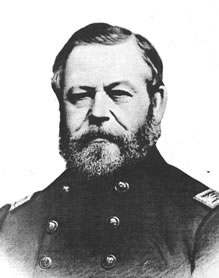Thomas Jackson Rodman | |
|---|---|
 Thomas Jackson Rodman | |
| Born | July 31, 1816 Salem, Indiana, U.S. |
| Died | June 7, 1871 (aged 54) Rock Island, Illinois, U.S. |
| Place of burial | |
| Allegiance | United States Union |
| Service | United States Army Union Army |
| Years of service | 1841–71 |
| Rank | |
| Commands | Watertown Arsenal Rock Island Arsenal |
| Battles / wars | Mexican–American War American Civil War |
| Other work | inventor |
Thomas Jackson Rodman (July 31, 1816 – June 7, 1871) was an American artillerist, inventor, ordnance specialist, and career United States Army officer.[1] He served as a Union Army officer during the American Civil War, in which he was noted for his many improvements and innovations concerning the artillery used by the Union forces.
He is especially remembered for developing the Rodman gun, which in various sizes saw extensive use in coastal defenses, and was called the "strongest cast iron cannon ever made." General Rodman also discovered the use of shaped gunpowder grains, in which properly compressing and shaping the gunpowder into pre-designed grain shapes allowed the control of gas production by the burning gunpowder. This resulted in increased muzzle velocities with lower maximum pressures when compared to performance with conventional ball powder.[2] The Rodman seven perforation grain was named after Rodman, and similar propellant grain shapes are still in use today in artillery, rockets, and automotive airbag inflators. After the conflict Rodman remained with the U.S. Army in his chosen profession, and is also noted for his alleged controversies while in command of the Watertown Arsenal.
- ^ Dupuy, p. 636.
- ^ Hayes, Thomas (1938). Elements of Ordnance A Textbook for Use of Cadets of the United States Military Academy. New York: John Wiley & Sons, Inc. p. 7. ISBN 978-1-163-15234-8.